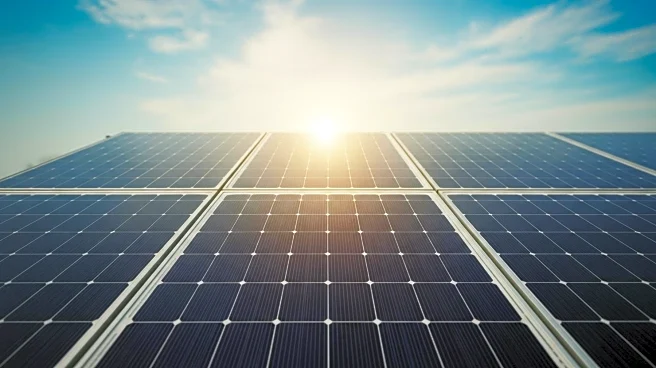What is the story about?
What's Happening?
Researchers at the University of New South Wales (UNSW) have announced a significant advancement in solar cell technology, potentially increasing the efficiency of silicon solar cells beyond 30% through the use of singlet fission. This breakthrough involves integrating a new class of stable organic molecules with silicon, which allows for the conversion of one high-energy photon into two excited electron/hole pairs, effectively doubling the electrical yield from the bluest part of the solar spectrum. The research, led by Professor Ned Ekins-Daukes, offers a practical pathway to higher output silicon solar cells without the added cost and complexity of tandem cells. This development builds on nearly two decades of collaboration among leading experts in the field, including Professors Tim Schmidt and Murad Tayebjee.
Why It's Important?
The implications of this breakthrough are substantial for the solar industry. Current silicon modules typically achieve efficiencies between 20% and 25%. By potentially increasing this efficiency to over 30%, fewer panels would be needed to achieve the same energy output, reducing overall system costs. This is particularly beneficial for applications in space-constrained environments such as rooftops, electric vehicles, and building-integrated photovoltaics. Additionally, the singlet fission process reduces heat generation, which could extend the lifespan of solar panels by approximately 4.5 years, lowering replacement costs and enhancing the value of long-term power purchase agreements. This advancement represents a significant step towards more sustainable and cost-effective solar energy solutions.
What's Next?
The next steps involve transitioning from laboratory research to practical applications. The UNSW team is moving towards developing commercial solar products that incorporate this technology. The industry is expected to trial these high-efficiency cells, which could lead to widespread adoption if successful. The research also opens avenues for discovering and optimizing new materials that could further enhance solar cell efficiency. As the solar industry continues to evolve, these developments could play a crucial role in meeting global energy demands sustainably.
Beyond the Headlines
This breakthrough not only promises to enhance solar cell efficiency but also highlights the importance of material stability and quality in photovoltaic systems. The use of stable and commercially viable materials in singlet fission photovoltaic devices addresses previous challenges with photochemical instability, paving the way for more reliable and durable solar panels. This research underscores the potential for innovative scientific approaches to drive significant advancements in renewable energy technologies.
AI Generated Content
Do you find this article useful?
















